
|
DENYFLT3
(Combat Camera Photo by Senior Airman Tana R. Hamilton)
A 510th Fighter Squadron F-16 flies with a German MIG 29 off the coast of Sardinia during a joint training exercise in Decimommanu, Sardinia in May, 1995. |
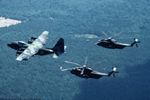
original at www.af.mil |
HC-130 refuels two MH-53Js
(U.S. Air Force Photo)
An HC-130 Combat Shadow refuels a pair of MH-53J Pave Lows over hilly terrain. |

original at www.af.mil |
3SHIP
(Photo By Technical Sergeant Russ Pollanen)
A MH-53 Pave Low from the 21st Special Operations Squadron, RAF Mildenhall England is escorted by two Hungarian Hind MI-24 gunships over Balaton Lake on their way to Szentkiralyszabadja airfield Veszprem, Hungary for participation in the Hungarian/US Bilateral Rescue Exercise Combined Rescue 95. |
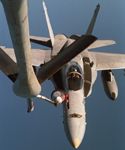
original at www.af.mil |
F-18Refuel
(Photo by Lieutenant Jack Liles)
An F-18 "Hornet" takes on fuel from a KC-135 over the Persian Gulf. |

original at www.af.mil |
RC-135 Rivet Joint
(U.S. Air Force photo)
The hog-nosed RC-135 reconnaissance aircraft, Rivet Joint, with its extensive antennae array, provides vital real-time battle management information to mission planners, commanders and warfighters. The aircraft is a high-altitude version of the C-135, which is a militarized version of the Boeing 707. The Rivet Joint aircraft, owned and operated by the 55th Wing, Offutt Air Force Base, Neb., provides direct, near real-time reconnaissance information and electronic warfare support to theater commanders and combat forces. The Rivet Joint crew consists of members of several 55th Wing squadrons. The pilots, navigators and maintainers are assigned to the 38th Reconnaissance Squadron. The electronic warfare officers, known as Ravens, and inflight maintenance technicians are from the 343rd Reconnaissance Squadron. The 97th Intelligence Squadron makes up the final portion of the crew. |

original at www.af.mil |
E-4B - National Airborne Operations Center
(U.S. Air Force photo)
The E-4B serves as the National Airborne Operations Center for the National Command Authorities. In case of national emergency or destruction of ground command control centers, the aircraft provides a modern, highly survivable, command, control and communications center to direct U.S. forces, execute emergency war orders and coordinate actions by civil authorities. The E-4B, a militarized version of the Boeing 747-200, is a four-engine, swept-wing, long-range, high-altitude airplane capable of being refueled in flight. Its larger size provides approximately triple the floor space of the earlier EC-135 command post. The main deck is divided into six functional areas: a National Command Authorities' work area, conference room, briefing room, an operations team work area, and communications and rest areas. An E-4B crew may include up to 114 people, including a joint-service operations team, an ACC flight crew, a maintenance and security component, a communications team and selected augmentees. |
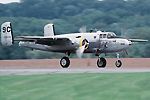
original at www.af.mil |
B-25 Mitchell taking off
(U.S. Air Force photo by Staff Sgt. Angela Stafford)
The B-25 Mitchell is named after the fearless U.S. Army Air Corps officer General Billy Mitchell who was court marshaled in 1924 for his outspoken belief in air power. The B-25 Mitchell received instant fame as a result of the attack on the Japanese mainland by Doolittle's Raiders in April of 1942. Sixteen B-25Bs took from the aircraft carrier Hornet at maximum gross weight, the mission raised the morale of the entire nation. Mitchell's have often been described as the best aircraft in it's class during WW II. Well suited for a variety of roles it served in every theater of operations. It was the first bomber lend-leased to Russia, and Mitchells saw service with the British, Dutch and Chinese Air Forces. The last duty B-25's were retired from Reese Air Force Base in 1959, however, they continued to fly for years in different uses all over the world. |

original at www.af.mil |
F-16Cs fly formation with a German Mig-29
(U.S. Air Force photo by Sgt. Tana Hamilton)
The United States bought 21 MiG-29 (not shown) fighters from the former Soviet republic of Moldova which are finding a new temporary home at Wright-Patterson Air Force Base, Ohio. Secretary of Defense William S. Cohen announced the purchase Nov. 4, saying it was part of an agreement with governments of the Newly Independent States, formerly parts of the Soviet Union, to ward off threats from "rogue states." "As a result of an accord that the United States signed with the Republic of Moldova in June of this year," Cohen said, "we recently purchased 21 advanced nuclear capable MiG-29 fighters from Moldova. The F-16 Fighting Falcon is a compact, multirole fighter aircraft. It is highly maneuverable and has proven itself in air-to-air combat and air-to-surface attack. It provides a relatively low-cost, high-performance weapon system for the United States and allied nations. |
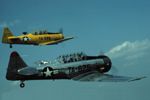
original at www.af.mil |
A pair of vintage T-6 "TEXAN's"
(U.S. Air Force photo)
The AT-6 advanced trainer was one of the most widely used aircraft in history. Evolving from the BC-1 basic combat trainer ordered in 1937, 15,495 Texans were built between 1938 and 1945. The USAAF procured 10,057 AT-6s; others went to the Navy as SNJs and to more than 30 Allied nations. Most AAF fighter pilots trained in AT-6s prior to graduation from flying school. Many of the "Spitfire" and "Hurricane" pilots in the Battle of Britain trained in Canada in "Harvards," the British version of the AT-6. To comply with neutrality laws, U.S. built Harvards were flown north to the border and were pushed across. In 1948, Texans still in USAF service were redesignated as T-6s when the AT, BT and PT aircraft designations were abandoned. To meet an urgent need for close air support of ground forces in the Korean Conflict, T-6s flew "mosquito missions" spotting enemy troops and guns and marking them with smoke rockets for attack by fighter-bombers. |
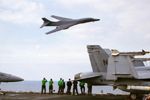
original at www.af.mil |
B-1B flies by the aircraft carrier USS Nimitz in the Persian Gulf
(DoD Photo by PH2 Christopher Ware)
An Air Force B-1B "Lancer" Bomber flies by the aircraft carrier USS Nimitz (CVN 68). Nimitz is deployed to the Persian Gulf in support of Operation Southern Watch. |

original at www.af.mil |
310th Airlift Squadron C-27A Spartan over the Panama Canal
(U.S. Air Force photo)
The C-27A Spartan is a twin turboprop engine aircraft designed to meet Air Force requirements for a rugged, medium size airland transport. The aircraft is particularly suited for short-to-medium range tactical operations into semi-prepared airfields as short as 1,800 feet. The C-27A is an all-weather, day/night transport with capabilities to perform medical evacuation missions. It can carry 24 litters and four medical attendants, or 34 ground troops. The Spartan has a cargo capacity of more than 2,000 cubic feet, or 12,000 pounds. The C-27A operates with a three-person crew of aircraft commander, copilot and loadmaster. The Air Force C-27A fleet consists of 10 aircraft stationed with the 24th Wing at Howard AFB, Panama, and flown byaircrews from 310th Airlift Squadron. |
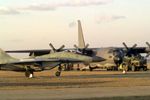
original at www.af.mil |
Hungarians, Americans train together during Carpathian Exchange exercise
(U.S. Air Force Photo)
KECSKEMET AIR BASE, Hungary (AFNS) - A Hungarian air force MiG-29 taxis past a U.S. Air Force MC-130P Combat Shadow on the flightline here during joint exercise training. The U.S. aircraft and personnel are deployed from the 352nd Special Operations Group at Royal Air Force Base Mildenhall, England. American aircraft and people are deployed to Hungary for an joint exercise dubbed Carpathian Exchange. The exercise began March 17 and ends March 27. |

original at www.af.mil |
B-2 B-1 and B-52 in flight
(U.S. Air Force photo)
The Air Force bomber force in flight together. The B-1B is a multi-role, long-range bomber, capable of flying intercontinental missions without refueling, then penetrating present and predicted sophisticated enemy defenses. It can perform a variety of missions, including that of a conventional weapons carrier for theater operations. The B-2 Spirit is a multi-role bomber capable of delivering both conventional and nuclear munitions. A dramatic leap forward in technology, the bomber represents a major milestone in the U.S. bomber modernization program. The B-2 brings massive firepower to bear, in a short time, anywhere on the globe through previously impenetrable defenses. Air Combat Command's B-52 is a long-range, heavy bomber that can perform a variety of missions. The bomber is capable of flying at high subsonic speeds at altitudes up to 50,000 feet (15,166.6 meters). It can carry nuclear or conventional ordnance with worldwide precision navigation capability. |
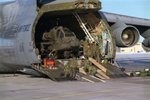
original at www.af.mil |
Northern Edge '98 - C-5A swallows Apache
(U.S. Air Force photo by Senior Amn. Michael Morford)
An Air Force Reserve C-5A from the 433rd Airlift Wing, Kelly AFB, Texas, delivers two AH-64 Apache helicopters to Eielson AFB, Alaska. The Apaches are assigned to the 4th batallion, 3rd Armored Cavalry Regiment at Fort Carson, Colorado. They are at Eielson for Northern Edge '98 and will be assembled in the 353rd Combat Training Squadron Thunderdome. They will fly to Fort Greely to participate in the exercise, back to Eielson, and then will be loaded back on the C-5's for transport back to Colorado. Exercise Northern Edge is the Alakan Commands Premier Annual Joint Training Exercise. It trains Alaskan based forces of the US Army Alaska, the 11th Air Force and Naval Forces Alaska, as well as Army, Air Force, Navy, Coast Guard and Marine Corps forces from the lower 48 states and Hawaii. |
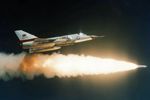
original at www.af.mil |
A vintage F-106 Delta Dart fires a rocket
(U.S. Air Force photo by Frank Garzelnick)
The F-106 all-weather interceptor was developed from the Convair F-102 ""designated the F-102B, it was redesignated F-106 because it had extensive structural changes and a more powerful engine. The first F-106A flew on Dec. 26, 1956, and deliveries to the Air Force began in July 1959. Production ended in late 1960 after 277 F-106As and 63 F-106Bs had been built. The weapon in the picture is the ATR, a training version of the AIR-2A Genie unguided rocket. The F-106 uses a Hughes MA-1 electronic guidance and fire control system. After takeoff, the MA-1 can be given control of the aircraft to fly it to the proper altitude and attack position. Then it can fire the Genie and Falcon missiles, break off the attack run, and return the aircraft to the vicinity of its base. The pilot takes control again for the landing. |
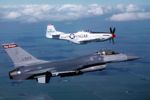
original at www.af.mil |
F-16C and P-51 together in flight
(U.S. Air Force photo)
An Air National Guard F-16 Fighting Falcon from the 119th Fighter Wing, North Dakota Air National Guard (NDANG), headquartered at Fargo, N.D., flies in formation with a WWII vintage P-51 Mustang. The F-16 Fighting Falcon is a compact, multirole fighter aircraft. It is highly maneuverable and has proven itself in air-to-air combat and air-to-surface attack. It provides a relatively low-cost, high-performance weapon system for the United States and allied nations. Mustangs served in nearly every combat zone, including the Pacific where they escorted B-29s to Japan from Iwo Jima. Between 1941-5, the AAF ordered 14,855 Mustangs (including A-36A dive bomber and F-6 photo recon versions), of which 7,956 were P-51Ds. During the Korean Conflict, P-51Ds were used primarily for close support of ground forces until withdrawn from combat in 1953. |

original at www.af.mil |
Veteran Air Force astronaut pilots P-63 Kingcobra
(U.S. Air Force Photo by Staff Sgt. Angela Stafford)
Former Air Force Astronaut Col. Frank Borman taxis his P-63 Kingcobra during the "Wings of Eagles" air show in Elmira, N.Y. The Army Air Forces never used the P-63 in combat, although some were used for training. The U.S. chose instead the P-47 Thunderbolt as its main fighter-bomber. Today, only four P-63s are flying. |
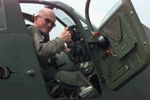
original at www.af.mil |
Veteran Air Force astronaut pilots P-63 Kingcobra
(U.S. Air Force Photo by Staff Sgt. Angela Stafford)
Warbird enthusiast and former Air Force Astronaut Col. Frank Borman after a flight in his P-63 Kingcobra. He purchased the WW II plane in 1996 after finding it at an airport in California where it had sat for 50 years. After 16 months of restoration it was ready for flight. |
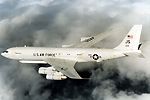
original at www.af.mil |
E-8C Joint STARS
(U.S. Air Force photo)
The E-8C Joint Surveillance Target Attack Radar System (Joint STARS)is the only airborne platform in operation that can maintain realtime surveillance over a corps-sized area of the battlefield. A joint Air Force - Army program, the Joint STARS uses a multi-mode side looking radar to detect, track, and classify moving ground vehicles in all conditions deep behind enemy lines. |

original at www.af.mil |
Global Hawk
(U.S. Air Force photo)
Global Hawk, an unmanned aerial vehicle manufactured by Teledyne Ryan Aeronautical, with a wingspan of 116 feet, will provide battlespace commanders near-real-time intelligence imagery from high altitudes for long periods of time, using SAR, moving target indicator, EO and infrared sensor systems. The data gathered by Global Hawk will be relayed to decision-makers via world-wide satellite communication links to its ground segment. A typical reconnaissance mission for Global Hawk might involve operating at a range of 12,500 nautical miles, at altitudes up to 65,000 feet for 38 to 42 hours. Capable of flying 3,000 miles to an area of reconnaissance interest, Global Hawk could then survey an area the size of Illinois (40,000 square nautical miles) for 24 hours, relaying intelligence data via ground and airborne links -- and return 3,000 miles to its operating base. Following the end of Global Hawk's flight testing program in April, U.S. Atlantic Command and Air Combat Command will conduct a military utility assessment to determine how they might use UAVs in future operations. |
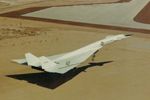
original at www.af.mil |
Air Force Heritage - XB-70 Valkyrie
(U.S. Air Force Photo)
Shown here landing at the end of Edward's 15,000-foot main runway, the North American XB-70 Valkyrie was designed to be a high-altitude bomber capable of flying for several hours at triple-sonic speeds. Powered by six 30,000-pound thrust General Electric YJ93 engines, the large canard-configured aircraft utilized the phenomenon of compression lift to ride its own shockwave for sustained flight at about 2,000 mph. The threat of improved high-altitude antiaircraft missiles ended the XB-70's bomber role, but the two prototype aircraft were used for aerodynamic research until 1969. |

original at www.af.mil |
Global Hawk, unmanned air vehicle
(U.S. Air Force Photo )
Global Hawk air vehicle number one, a high- altitude, long endurance unmanned air vehicle, took off from Edwards AFB main runway for it's first airworthiness evaluation and payload demonstration flight. Global Hawk's mission is to provide military field commanders with a high-altitude, long- endurance system that can obtain high resolution, near- real-time imagery of large geographic areas. |
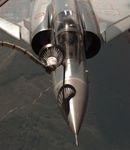
original at www.af.mil |
Allied Force - French Air Force Mirage 2000 is refueled
(U.S. Air Force photo by Master Sgt. Joe Cupido)
A French Air Force Mirage 2000 is refueled by a KC-135E Stratotanker from the 940th Air Refueling Wing during an Allied Force combat support mission on Saturday, May 22, 1999. The Mirage pilot is flying a NATO Combat Air Patrol mission that protects refueling tankers and other unarmed aircraft in the area. |

original at www.af.mil |
KC-135 air refuels B-2 Spirit
(U.S. Air Force photo by Senior Master Sgt. Rose Reynolds)
A KC-135 from the 22nd Air Refueling Wing, McConnell Air Force Base, Kansas refuels a B-2 Spirit from the 509th Bomb Wing, Whiteman Air Force Base, Missouri. The 22nd Air Refueling Wing's primary mission is to provide Global Reach by conducting air refueling and airlift where and when needed. It operates in that role as part of the Air Mobility Command's commitment to Global Reach providing Air Force assets in support of world peace through readiness and the deterrence of armed aggression. This commitment also includes supporting the Department of Defense in many contingency situations, from strategic force projection and strategic force mobility, to humanitarian assistance. |
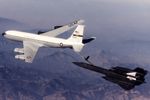
original at www.af.mil |
KC-135 refuels NASA SR-71
(Photo courtesy NASA)
A NASA SR-71 refuels from an Edwards Air Force Base, Calif., KC-135 during the first flight of the NASA/Rocketdyne/Lockheed Martin Linear Aerospike SR-71 Experiment (LASRE). The flight took place Oct. 31, 1997, at NASA's Dryden Flight Research Center, at Edwards. The aircraft flew for one hour and fifty minutes, reaching a maximum speed of Mach 1.2 before landing at Edwards, successfully validating the SR-71/linear aerospike experiment configuration. The goal of the first flight was to evaluate the aerodynamic characteristics and the handling of the SR-71/linear aerospike experiment configuration. The engine was not fired during the flight. Linear Aerospike rocket engines will power NASA's X-33 Advanced Technology Demonstrator, scheduled to fly in 1999. The NASA/Rocketdyne/Lockheed Martin Linear Aerospike SR-71 Experiment is designed to gather data on the aerospike's exhaust plume as it travels through the transonic region of flight (just below to just above Mach 1). Linear aerospike rocket engines have been laboratory and ground tested many times during the past thirty years, but have never flown. |

original at www.af.mil |
A-10 Thunderbolt and F-16 Fighting Falcon
(U.S. Air Force photo by Senior Master Sgt. Rose Reynolds)
An A-10 Thunderbolt II, and F-16 Fighting Falcon from the 52nd Fighter Wing, Spangdahlem Air Base, Germany, fly in formation over southern Germany. The A-10 is the first Air Force aircraft specially designed for close air support of ground forces. They are simple, effective and survivable twin-engine jet aircraft that can be used against all ground targets, including tanks and other armored vehicles. The F-16 is a compact, multirole fighter aircraft. It is highly maneuverable and has proven itself in air-to-air combat and air-to-surface attack. It provides a relatively low-cost, high-performance weapon system for the United States and allied nations. |
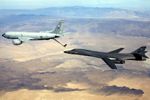
original at www.af.mil |
KC-135R refuels a B-1B over southern California
(U.S. Air Force Photo by Staff Sgt. Mark A. Borsch)
A KC-135R Stratotanker from the 452nd Flight Test Squadron at Edwards Air Force Base, Calif., refuels a B-1B Lancer from the 37th Bomb Squadron, 28th Bomb Wing, Ellsworth Air Force Base, S.D., over the dry lake beds of southern California. The Lancer was part of the ongoing weapons flight-testing program at Edwards. Over 5000 flying hours a year are flown to support these tests. |
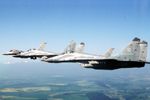
original at www.af.mil |
Two F-16Cs fly in formation with German MiG-29s
(U.S. Air Force Photo by Senior Airman Sean Worrell)
Air to air view of two German Air Force MIG-29 fighters and two Air Force Reserve F-16 Fighting Falcons flying in fingertip formation. The lead aircraft is a 302nd Fighter Squadron F-16C and on his right wing is the flag ship of the 944th Fighter Wing, both deployed from Luke Air Force Base, Arizona. The F-16 Fighting Falcon is a compact, multirole fighter aircraft. It is highly maneuverable and has proven itself in air-to-air combat and air-to-surface attack. It provides a relatively low-cost, high-performance weapon system for the United States and allied nations. In an air combat role, the F-16's maneuverability and combat radius (distance it can fly to enter air combat, stay, fight and return) exceed that of all potential threat fighter aircraft. It can locate targets in all weather conditions and detect low flying aircraft in radar ground clutter. In an air-to-surface role, the F-16 can fly more than 500 miles (860 kilometers), deliver its weapons with superior accuracy, defend itself against enemy aircraft, and return to its starting point. An all-weather capability allows it to accurately deliver ordnance during non-visual bombing conditions. |

original at www.af.mil |
KC-135R refuels a B-1B over southern California
(U.S. Air Force Photo by Staff Sgt. Mark A. Borsch.)
A KC-135R Stratotanker from the 452nd Flight Test Squadron at Edwards Air Force Base, Calif., refuels a B-1B Lancer from the 37th Bomb Squadron, 28th Bomb Wing, Ellsworth Air Force Base, S.D., over the dry lake beds of southern California. The Lancer was part of the ongoing weapons flight-testing program at Edwards. Over 5000 flying hours a year are flown to support these tests. |
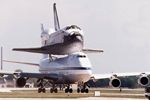
original at www.af.mil |
NASA's unique aircraft make surprise stop at Whiteman
(U.S. Air Force Photo)
The Space Shuttle Columbia sits atop a specially refitted Boeing 747 as it taxies on to the ramp at Whiteman Air Force Base, Mo. The special visitors stopped recently at Whiteman to spend the night during a cross-country trip. (Courtesy photo) |

original at www.af.mil |
Bright Star'99 - Fly over Egyptian pyramids
(U.S. Air Force Photo)
Aircraft participating in Bright Star exercise fly over the pyramids in Egypt. Leading the pack is a B-1B bomber from the 28th Bomb Wing, Ellsworth AFB, S.D. The coalition fighters in trail are as follows: Egyptian F-16, U.S. Marine Harrier (AV-8), Egyptian Alpha Jet, French Mirage-5, French Mirage-2000, Greek F-16, Itialian AMX, Egyptian F-4, U.S. Marine Corp F-18, Jordanian F-16, Egyptian Mig-21, and a U.S. Navy F-14. |
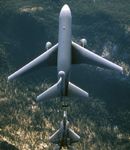
original at www.af.mil |
Raptor Refueling
(U.S. Air Force Photo by Judson Brohmer)
A KC-10 tanker from Travis AFB, Calif, refuels an F-22 Raptor Tuesday, Nov 19, 1999. The Raptor's refueling was the first one by a KC-10 aircraft as part of the F-22 test program. Once fielded, the F-22 Raptor will ensure that U.S. air superiority remains unchallenged for decades to come. |

original at www.af.mil |
F-22 aptor Refueling with KC-10
(U.S. Air Force Photo by Judson Brohmer)
A KC-10 tanker from Travis AFB, Calif, refuels an F-22 Raptor Tuesday, Nov 19, 1999. The Raptor's refueling was the first one by a KC-10 aircraft as part of the F-22 test program. Once fielded, the F-22 Raptor will ensure that U.S. air superiority remains unchallenged for decades to come. |
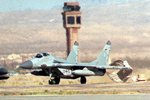
original at www.af.mil |
MiG Alley moves to the valley
(U.S. Air Force Photo by John Broussard)
Two German MiG-29 aircraft taxi toward parking ramp locations at Nellis Air Force Base, Nev., shortly after landing here Oct. 22. The German aircraft are participating in Air Combat Command's Red Flag exercise here through Nov. 6. |

original at www.af.mil |
Fulcrums in Red Flag Exercise
(U.S. Air Force Photo Photo by Staff Sgt. Kevin J. Gruenwald)
German MiG-29s fly in a historic formation with Nellis F-16 Fighting Falcons of the 414th Combat Training Squadron over the ranges during Red Flag exercises. The squadron is from the 73rd Steinhoff Fighter Wing from Laage, Germany. Units from around the world participated in the Red Flag exercise, which is designed to provide aircrews from the U.S., allied nations and coalition forces with superior combat training. |
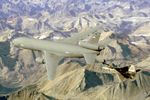
original at www.af.mil |
Travis KC-10 refuels Raptor for first time
(U.S. Air Force Photo by Judson Brohmer)
An F-22 Raptor connects with a KC-10 Extender during tests to determine compatibility between the two planes. The refueler crew, from Travis Air Force Base, Calif., assisted evaluators from the 452 Flight Test Squadron, Edwards Air Force Base, Calif., in conducting these tests which marked the first time the Raptor was refueled by the KC-10. During four test flights, more than 250 boom connections were made and some 35,000 pounds of fuel was transferred. |
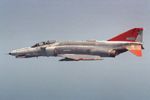
original at www.af.mil |
QF-4 drone over the Gulf of Mexico
(U.S. Air Force photo by Senior Airman Matthew C. Simpson)
An unmanned QF-4 drone flies over the over Gulf of Mexico on Jul. 17, 1998. Use of these former fighter jets as remote controlled drones gives pilots a realistic target during training missions where live missiles are launched. |

original at www.af.mil |
Mi-24 Hind banks over desert
(U.S. Air Force Photo by Tech. Sgt. David W. Richards)
Adversary aircraft Mi-24 Hind helicopter attempts to locate a simulated downed airman for capture. This provids a realistic hostile threat to Search and Rescue (SAR) operations during the Desert Rescue exercise. This is the premiere joint services SAR training conducted on the ranges of Fallon Naval Air Station, Nevada. |
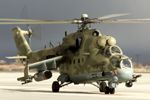
original at www.af.mil |
Mi-24 Hind Returns From The Hunt
(U.S. Air Force Photo by Master Sgt. Steven M. Turner)
A Mi-24 Hind attack helicopter from the Army Test and Evaluation Center, Threat Support Activity, Las Vegas, Nev., taxis back after providing simulated hostile threats to Search and Rescue operations during Desert Rescue on Feb. 17, 2000. Desert Rescue is a Joint Service Combat Search and Rescue exercise designed to fully integrate planning and execution of both immediate and dedicated missions. |
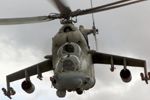
original at www.af.mil |
Mi-24 Hind used during Desert Rescue
(U.S. Air Force Photo by Master Sgt. Steven M. Turner)
A Mi-24 Hind attack helicopter from the Army Test and Evaluation Center, Threat Support Activity, Las Vegas, Nev., passes over on the way to provide simulated hostile threats to Combat Search and Rescue operations during Desert Rescue on Feb. 17, 2000. Desert Rescue is a Joint Service Combat Search and Rescue exercise designed to fully integrate planning and execution of both immediate and dedicated missions. |

original at www.af.mil |
Thunderbolt and Eagles over Randolph Air Force Base
(U.S. Air Force Photo by Technical Sgt. Lance Cheung)
In the lead is the P-47 Thunderbolt "Tarheel Hal" followed by two demonstration team F-15 Eagles from 33rd Fighter Wing (EG), Eglin Air Force Base, Fla. and the 1st Fighter Wing (FF), Langely Air Force Base, Va. They are conducting a training mission over Randolph Air Force Base, TX. During the Air Combat Command Heritage Flight Conference six single-ship demonstration teams will discuss operations and conduct flight training with the "warbird" pilots who will fly with them as a team during the upcoming air show season. |
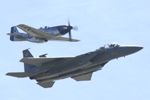
original at www.af.mil |
Heritage Flight of P-51 and F-15
(U.S. Air Force Photo by Technical Sgt. Lance Cheung)
An F-15 Eagle flies in formation with a P-51 Mustang during Heritage Flight Program training March 4 at Randolph Air Force Base, Texas. This was part of the Air Combat Command Heritage Flight Conference that provides a forum for its six single-ship demonstration teams to discuss operations and conduct flight training with the "warbird" pilots who will fly with them as a team during the upcoming air show season. |

original at www.af.mil |
Heritage Flight fly-by of Eagle, Mustang and Falcon
(U.S. Air Force Photo by Technical Sgt. Lance Cheung)
P-51D-10 Mustang "Moonbeam McSwine" is flanked in formation by an U.S. Air Force demostration team F-15D Eagle from the 33rd Fighter Wing, Eglin Air Force Base, Fla. and F-16 Fighting Falcon from the 388th Fighter Wing, Hill Air Force Base, Utah, during Heritage Flight Program training March 4 at Randolph Air Force Base, Texas. This was part of the Air Combat Command Heritage Flight Conference that provides a forum for its six single-ship demonstration teams to discuss operations and conduct flight training with the "warbird" pilots who will fly with them as a team during the upcoming air show season. |
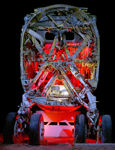
original at www.af.mil |
Phoenix Rising - Sliced B-52s continue to serve their country
(U.S. Air Force Photo by Technical Sgt. Lance Cheung)
This B-52G Stratofortress from the Cold War stands ready to serve despite its retirement to a 2,600-acre Aerospace Maintenance and Regeneration Center, Davis-Monthan Air Force Base site. Analyses show that the B-52H's life span can be extended beyond the year 2045, possibly making the aircraft the first "century" weapons system. To do that, parts and substructures from the remaining B-52G's are needed for the H models. The cutting of the aircraft complies with term of the 1994 Strategic Arms Reduction Treaty. The airframe remains visible for a 90-day period following aircraft destruction, this allows for inspection to verify treaty compliance by national technical means or satellite. AMARC located in the Arizona desert, has the basic mission of storage, reclamation, regeneration and disposal of aircraft for the Department of Defense. (See "Phoenix Rising" - Airman Magazine, April 2000). |
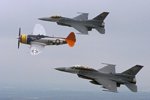
original at www.af.mil |
Thunderbold leads Vipers over Randolph AFB
(U.S. Air Force Photo by Technical Sgt. Lance Cheung)
In the lead is the P-47 Thunderbolt "Tarheel Hal" followed by two demonstration team F-16 Fighting Falcons (a.k.a Vipers) from the 20th Fighter Wing (SW), Shaw Air Force Base, SC and the 388th Fighter Wing (HL), Hill Air Force Base, Utah. They are conducting a training mission over Randolph Air Force Base, TX during the Air Combat Command (ACC) Heritage Flight Conference. This event provides a forum for ACCs six single-ship demonstration teams to discuss operations and conduct flight training with the "warbird" pilots who will fly with them as a team during the upcoming air show season. |

original at www.af.mil |
Boeing 757 tests Raptor avionics
(U.S. Air Force Photo)
The F-22 Flying Test Bed, a modified Boeing 757, offers several benefits to the F-22 development program. The test bed reduces risk, as well as future flight-testing hours, by enabling extensive in-flight testing, evaluation and troubleshooting. The test avionics are operated from a simulated F-22 cockpit installed in the flying test bed cabin. The cockpit has primary and secondary F-22 displays, as well as a throttle and stick. |
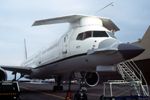
original at www.af.mil |
Boeing 757 tests Raptor avionics
(U.S. Air Force Photo)
The F-22 Flying Test Bed, a modified Boeing 757, offers several benefits to the F-22 development program. The test bed reduces risk, as well as future flight-testing hours, by enabling extensive in-flight testing, evaluation and troubleshooting. The test avionics are operated from a simulated F-22 cockpit installed in the flying test bed cabin. The cockpit has primary and secondary F-22 displays, as well as a throttle and stick. |
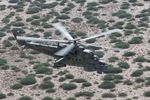
original at www.af.mil |
Roving Sands - Mi-24 Hind on the prowl
(U.S. Air Force Photo by Technical Sgt. Cary Humphries)
A Soviet made MI-24 Hind helicopter gunship flown by U.S. Army Test and Evaluation (ATEC) Command Threat Support Activity pilots, Biggs Army Airfield, Fort Bliss, Texas, attacks Air Defense Artillery (ADA) units during Roving Sands 2000 on June 18, 2000. Stretching across the United States, incorporating all four Services and their National Guard and Reserve components, and with ever growing multi-national participation the total force exercise Roving Sands is the world's largest joint theater air andmissile defense exercise. |
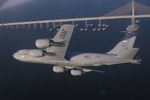
original at www.af.mil |
KC-135R Stratotanker over a Florida bridge
(U.S. Air Force Photo by Master Sgt Keith Reed)
A KC-135R Stratotanker assigned to the 6th Air Refueling Wing, 91st Air Refueling Squadron, at MacDill Air Force Base, Fla., flies a training mission over central Florida. The KC-135's principal mission is air refueling. This asset greatly enhances the U. S. Air Force's capability to accomplish its mission of Global Engagement. It also provides aerial refueling support to U.S. Navy, U.S. Marine Corps and allied aircraft. Four turbofans, mounted under 35-degree swept wings, power the KC-135 to takeoffs at gross weights up to 322,500 pounds (146,285 kilograms). Nearly all internal fuel can be pumped through the tanker's flying boom, the KC-135's primary fuel transfer method. A special shuttlecock-shaped drogue, attached to and trailed behind the flying boom, may be used to refuel aircraft fitted with probes. An operator stationed in the rear of the plane controls the boom. |
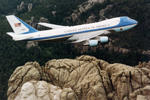
original at www.af.mil |
Air Force One over Mount Rushmore
(U.S. Air Force Photo)
The mission of the VC-25A aircraft -- Air Force One -- is to provide air transport for the president of the United States. The presidential air transport fleet consists of two specially configured Boeing 747-200B's -- tail numbers 28000 and 29000 -- with the Air Force designation VC-25A. When the president is aboard either aircraft, or any Air Force aircraft, the radio call sign is "Air Force One." |
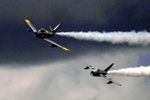
original at www.af.mil |
F-86s and Mig-15s engaged in mock air combat
(U.S. Air Force Photo by Master Sgt. Glenn Wilkewitz)
Selfridge Air National Guard Base held its biennial air show honoring Korean War veterans. It also featured F-86s and Mig-15s engaged in mock air combat in the Michigan skies. The event included displays of 90 planes on the ground and in the air from all of the service. |
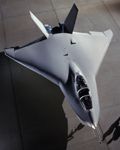
original at www.af.mil |
412th Test Wing and X-32 Joint Strike Fighter
(Photo courtesy Boeing)
The 412th Test Wing at Edwards Air Force Base, CA, is becoming more agile. To continue testing aircraft such as Boeing's X-32 Joint Strike Fighter and to remain a prominent leader in flight-testing to continue meeting the warfighter's needs, the 412th is looking to become more agile. For many people, agility means adapting or responding to change. But it goes deeper than that. It means having an enterprise-wide strategy for being competitive during chnage, which is an ever-increasing notion of today's business world. Moreover, agility means anticipating shifts and, therefore, being proactive. It's a strategy for competitiveness in era of accelerated transformations. "An agile organization can sense the future and then very quickly react to accommodate such changes as they happen," said Col. Perry Lamy, commander of the 412th Test Wing. |
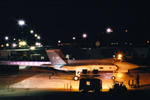
original at www.af.mil |
Joint Strike Fighter X-35A runs up engines
(Photo courtesy Lockheed Martin by Peter A. Torres/ Marty Wolin)
In final preparations for first flight, the Lockheed Martin X-35A Joint Strike Fighter (JSF) runs its engine in full afterburner as the LM JSF team validates performance predictions of the Pratt & Whitney JSF F119-611 engine. LM test pilot Tom Morgenfeld executed dynamic accelerations and decelerations, military power (maximum non-afterburner power) and full power (with afterburner) settings while the team verified that electrical, hydraulic, avionics and all other subsystems performed properly under engine-powered operations. The testing took place at Lockheed Martin Aeronautics Company in Palmdale, Calif. |
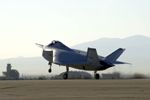
original at www.af.mil |
First Joint Strike Fighter X-32A departs Palmdale
(Photo courtesy of Boeing)
Boeing's X-32A Joint Strike Fighter demonstrator departs from Palmdale, Calif., for a short flight to nearby Edwards Air Force Base. Boeing's X-32A and the other JSF demonstrator, Lockheed Martin's X-35A, will be tested at Edwards for nearly five months. |
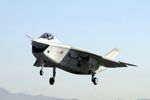
original at www.af.mil |
First Joint Strike Fighter lands at Edwards
(Photo by Ron Bookout)
Joint Strike Fighter test pilot for Boeing's X-32A, Fred Knox, lands the demonstrator aircraft at Edwards Air Force Base, Calif., Sept. 18. During the flight, Knox put the plane through several initial airworthiness tests, including flying qualities and sub-systems checkout. The X-32A, along with Lockheed Martin's X-35A, will be tested here for five months before "B" models are tested at the Naval Air Station Patuxent River test site in Maryland. |
^^ TOP ^^
|

